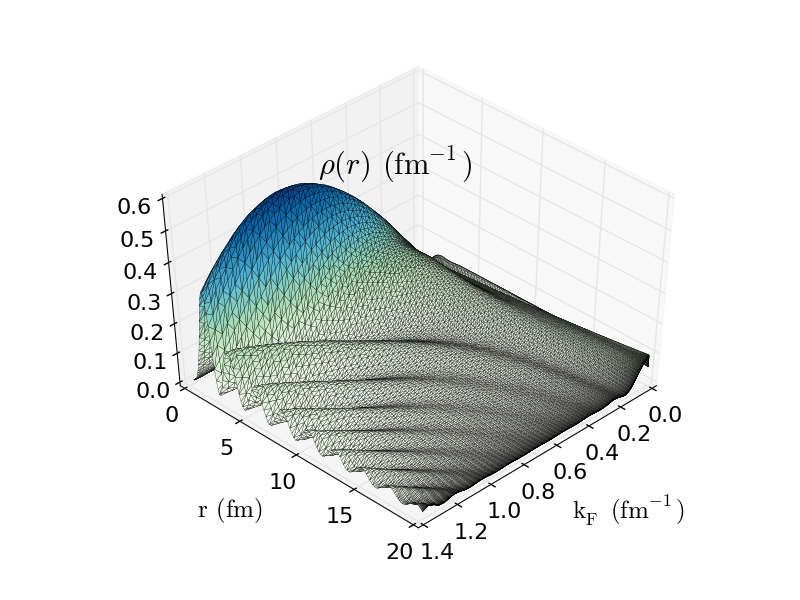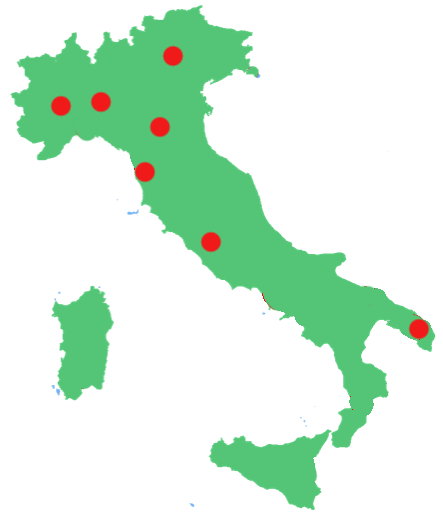Scientific activities of the various Research Units
Bologna
- Pairing from microscopic forces and applications to neutron star cooling
- Development of microscopic optical potentials (in collaboration with the Pavia group)
- Mean-field approaches to nuclear structure
 The Bologna group covers three areas of reseach:
The Bologna group covers three areas of reseach:
Lecce
-
In these last years, the group of Lecce, in collaboration with the
group of the University of Granada (Spain), has developed a fully
self-consistent, and parameter free, theoretical framework which
can be applied to study nuclei in all the regions of the nuclear
chart. The description is based on Hartree-Fock plus Random Phase
Approximations calculations carried out with a unique effective
universal finite-range interaction. At present we are developing
calculations which consider the pairing in the same framework, with
the aim to make applications for nuclei which are interested for the double beta decay.
Pavia
-
The research activity of the Pavia unit is focussed on electroweak interactions with nuclei. Electron scattering is a preferential tool to investigate nuclear properties. Additional information can be obtained from neutrino scattering. A careful description of nuclear effects in neutrino-nucleus scattering is mandatory for the determination of neutrino oscillation parameters.
Models developed for electron scattering and tested in comparison with electron scattering data can be extended to neutrino nucleus scattering. The aim is to obtain, from the comparison and the improvement of different
models, a unified and consistent description of electron and neutrino-induced nuclear reactions on stable and exotic nuclei.
Pisa
-
The main research interests of the Pisa unit concern the study of many-body nuclear systems adopting microscopic approaches. In particular, we perform calculations of infinite nuclear matter based on
the Brueckner-Hartree-Fock method. One of our current focus, is to determine microscopic two-
and three-body nuclear interactions, derived in the framework of chiral perturbation theory, able to simultaneously reproduce binding energies of light nuclei and the properties of nuclear matter around saturation density. The equation of state (EoS) of β-stable nuclear matter derived within this microscopic approach will be then used for the calculation of neutron stars properties in general relativity.
Another topic of our research is the study of hyperonic matter and in particular the investigation of the effect of the nucleon-hyperon and the nucleon-nucleon-hyperon interactions on the EoS of
β-stable hyperonic matter. Hyperonic interactions turn out to be particularly important to determine the composition and the maximum mass of hyperon stars to be compared with measured neutron star masses.
We also study the quark deconfinement phase transition, which is expected to occur in the central core of "massive" neutron stars, and its astrophysical implications.
Torino
-
The research activity of the Turin unit is mainly devoted to the study of electroweak interactions in nuclei, in particular neutrino-nucleus scattering and its connection to electron-nucleus reactions. Special emphasis is put on the role of relativity: this is studied by employing nuclear models which embed relativistics dynamics and are suited to be applied to typical kinematics of present and future neutrino experiments at FermiLab and J-PARC. The role of meson exchange currents and their associated correlations is studied in a relativistic context. The project involves several collaborations with both italian (Pavia, Rome) and foreign (Sevilla, Granada, Madrid, MIT, Sofia) institutions.
Roma 1
-
The research activity of the Rome unit, while focusing on different subjects, such
as the electroweak interactions of nuclei and the structure compact stars, is mainly
aimed at developing a unified framework, allowing for a consistent description based
on a single dynamical model. A remarkable example of this approach are the studies
of neutrino interactions with nuclei and nuclear matter in the energy range extending
from the few MeV region--relevant to astrophysical applications--to the few GeV
region---relevant to the interpretation of the signals detected by experimental
searches of neutrino oscillations.
TIFPA - Trento
-
The Trento unit is particularly active in the development and implementation of
computational techniques for the study of problems of interest in nuclear and
condensed matter physics. In particular we have developed a widespread expertise
in Monte Carlo techniques, both as a way to compute ground- and excited-state
properties of many-body systems, and as a solution of general transport problems.
Applications range from the computation of the properties of nuclei and nuclear matter (including
strangeness), and lattice nuclei, to plasmas in stellar conditions, many electron
systems (with applications to quantum chemistry and material science), and simulations
for hadroterapy.
The group is active not only in the application of existing techniques, but in the
development of new and more efficient algorithms.
^ Back to Top


